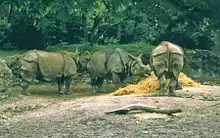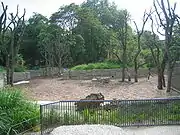History of Zoo Basel
The Zoo Basel is located in Basel, Switzerland. Established in 1874, it is Switzerland's oldest and largest zoo (by number of animals) and a major tourist attraction with nearly 1.7 million visitors per year.[1]
 Zoo Basel logo | |
| Date opened | July 3, 1874 |
|---|---|
| Location | Basel, Switzerland |
| Coordinates | 47°32′50″N 7°34′44″E |
| Land area | 32.12 acres (13.00 ha) |
| No. of animals | 6,894 (2008 / about 5,000 in the aquarium) |
| No. of species | 645 (2008) |
| Annual visitors | 1,698,152 (2008) |
| Major exhibits | Africa, Antelope House, Aquarium, Australis, Bird House, Elephant House, Etoscha, Gamgoas, Kinderzoo, Monkey House, and Rhino Exhibit in the Sautergarden |
| Website | http://www.zoobasel.ch |
In 1870, the Ornithologiegesellschaft and the city of Basel started a project to establish a zoo where visitors could see Swiss and European animals. For this, the city provided land in the Birsig valley, which was, back then, outside the city walls South of Basel.
| Zoo Basel directors[2] | |
|---|---|
| 1874-1875 | "Herr" Müller |
| 1875-1876 | Inspektor Seydel |
| 1876–1914 | Gottfried Hagmann |
| 1914–1944 | Adolf Wendnagel |
| 1944–1953 | Heini Hediger |
| 1953–1979 | Ernst Lang |
| 1979–1995 | Dieter Rüedi |
| 1995–2001 | Peter Studer |
| since 2001 | Oliver Pagan |
1874-1900
This time period was marked by the openening of Zoo Basel in 1874 and by the zoos struggle for survival during the first years.[2] It also started the attachment of Basel's population to "its" zoo, which is evidenced by the local popularity of the Indian elephant Miss Kumbuk and several donations of animals and funds.
| Year | Event | Details |
|---|---|---|
| 1874 | Opening day | On July 3, 1874, Zoo Basel opened its doors |
| 1884 | Expansion | The zoo expanded towards Binningen and had as its new center the festival grounds, where diverse exhibits took place |
| 1886 | First elephant | The first Indian elephant, Miss Kumbuk, was brought to Basel by Paul and Fritz Sarasin |
| 1890 | First lions | The first arrived in Basel |
| 1891 | Lion birth | On March 19, 1891 the first lion cub was born |
| 1891 | Elephant House | A new house was opened for the popular Indian elephant Miss Kumbuk and for some zebras |
| 1900 | First apes | The female orangutan Kitty came to Basel |
1901-1950
The zoo grew in size, popularity, and in number of animals. During the two world wars the zoo suffered, but was not hit by any bombs. It quickly recovered after World War II and took advantage of the opportunity to import foreign animals again.
| Period overview[3] | ||
|---|---|---|
| Year | Event | Details |
| 1901 | Large donation | Mr. Johannes Beck, a local gold smith, donated SFr. 750'000 to Zoo Basel. In his honor, the zoo celebrates every year the Johaness Beck Day. On June 24, entrance to the zoo is free of charge |
| 1904 | Carnivor House | The first carnivor house opened, which included lions and a reptile exhibit |
| 1910 | Antelope House | A new antelope house opened, which is, as of April 2010, the oldest building at Zoo Basel |
| 1914 | Death of Miss Kumbuk | With great sorrow Basels population parted from "their" elephant |
| 1919 | New elephant | After a long search, the African elephant Jenny was acquired from Circus Krone to replace Miss Kumbuk |
| 1927 | Sealion Exhibit | Urs Eggenschwyler designed the new sea lion rock which opened in 1927 |
| 1935 | New restaurant | With a great financial effort the old tavern was replaced with a modern restaurant |
| 1937 | Worst day in history | Many animals died because of an outbreak of the foot-and-mouth disease |
| 1947 | New giraffes | Just after the second world war new giraffes were imported |
| 1949 | Okapi | The first okapi arrived in Basel, however, it died only two months after arriving |
1951-2000

This time period was marked by the transformation of animal collecting cages to in- and outdoor exhibits. Zoo Basel called it "creating an animal park".
| Period overview[3][4] | ||
|---|---|---|
| Year | Event | Details |
| 1956 | Lion House | A new lion house was built that stood until the development of the Gamgoas project |
| 1961 | Main entrance | The main entrance was moved toward the Birsig creek |
| 1966 | Elephant birth | The first African elephant, Ota, was born in Basel |
| 1969 | Monkey House | The current monkey house opened |
| 1972 | Vivarium | The aquarium, or vivarium, opened. |
| 1992 | Elephant birth | The male African elephant Pambo was born. He later was transferred to the Vienna zoo |
| 1992/3 | Africa Exhibit | For the first time three different animal species shared one exhibit. The outdoor exhibit and three new houses opened |
| 1997 | Lori House | A new home for the rainbow lorikeets in the Sauter Garden |
| 1998 | Pelicans | The pelican lake and their new house was constructed. The exhibit also includes a new bridge over a small waterfall |
| 1999 | Snow leopard | The snow leopards moved into a new exhibit in the Sauter Garden |
2001-present

2008 / 2010: Rhino house and outdoor exhibit
In 2008, the renovated and expanded Indian rhinoceros house opened and two years later the new rhino outdoor exhibit opened, which also included muntjacs, and Oriental small-clawed otters.
2011 / 2012: Monkey house and exhibit
Starting in April/May 2010 the monkey house and the surrounding area will undergo extensive construction. This includes the tearing down of the small monkey house (home of the ring-tailed lemurs), the macaques rock, the children's play ground, the old bear exhibits, and several paths.
On June 30, 2011 the enlarged monkey house opened. While visitors have the same amount of space available, the apes' space more than double from 340 square metres (3,700 sq ft) to 700 square metres (7,500 sq ft).[5]
The old outer walls were torn down and the living quarters were extended in depth and height. Eventually, there will be additional compartments with no public access, a service tunnel, worker quarters, and restrooms added.
In summer 2012 five large outdoor "cages", the remodeled monkey house roof, a new ape playground, and several new paths will open. The outdoor cages will have a double net layer; one for safety reasons and the other, outer layer, for plants to grow on. The cages' heights will be 16 metres (52 ft) for the orangutans and 11 metres (36 ft) for the other apes. The apes' outdoor area will grow from today's 70 square metres (750 sq ft) to over 2,000 square metres (22,000 sq ft). The children's playground is planned to go along with the jungle theme - similar to the one in the Etosha exhibit. The paths on the monkey roof, around the new cages, by the main entrance, and the former bear exhibits will be adjusted and/or newly constructed.
| Period overview[4] | ||
|---|---|---|
| Year | Event | Details |
| 2001 | Etosha house | Etosha house and outdoor exhibits |
| 2003 | Gamgoas house | Gamgoas house with lion and African wild dog outdoor exhibits |
| 2004 | Lori exhibit | With a generous donation from the Winterthur Insurance, the Lori house received an outdoor exhibit |
| 2006 | Australis | Opening of the Australis house and outdoor exhibits |
| 2006 | Rhino House | The renovated and expanded Indian rhinoceros house opened |
| 2008 | Rhino Exhibit | The new rhino outdoor exhibit opened and included also muntjacs, and Oriental small-clawed otters |
| 2010 | Monkey Rock | The macaques (monkeys) moved into a new exhibit in the Sauter Garden |
Former animals
A short list of previous animals kept at Zoo Basel can be found towards the bottom of List of animals at Zoo Basel.
References
- (in German) Basler Zolli beliebt Archived 2012-03-07 at the Wayback Machine 20min.ch, written 2009-02-23, retrieved 2012-09-08
- (in German) Zoo Basel und andere um 1870 in der Schweiz. Verband Deutscher Zoodirektoren. retrieved 2012-08-18
- (in German) Geschichte Zoo Basel. Zoo Basel, retrieved 2012-8-18
- (in German) Geschichte Zoo Basel. Zoo Basel, retrieved 2012-8-18
- (in German) Die Zolli-Affen sind zurück im Haus. Basler Zeitung, retrieved 2011-10-23
External links
| Wikimedia Commons has media related to History of Zoo Basel. |